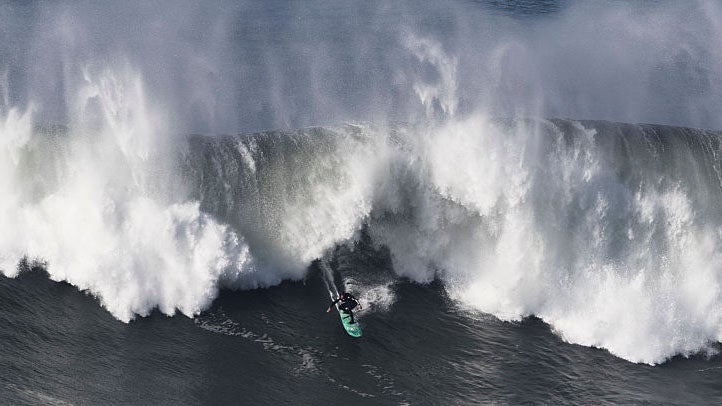On February 11, 2020, fans of big-wave surfing watched Portuguese pro Alex Botelho nearly drown on the of the inaugural Nazaré Tow Surfing Challenge, a contest on the World Surf League’s Big Wave World Tour. Two years later, Botelho has filed a lawsuit against the WSL, accusing the organization of a series of decisions that he says have resulted in lifelong physical, psychological, and financial damages.
The 29-page complaint was filed on February 9 in the Superior Court of Los Angeles County, and it alleges that the WSL ignored concerns that some competitors voiced about the event’s safety plan and then lied to the surfers about multiple critical elements of the plan. “As a result of these misrepresentations and failures of due care,” the complaint reads, “[Botelho] was left in the water unconscious for up to six minutes before he was pulled from the sea not breathing.”
���ϳԹ��� was unable to reach Botelho for comment, but his lawyers Neil Fraser and James C. Carr agreed to speak. “We’re not blaming the city of Nazaré, and we’re not blaming the rescue personnel who were there and did as good of a job as they could,” Fraser said. “It’s just that WSL was the one that dropped the ball.”
The accident came in the sixth hour of competition, during a heat that wasn’t initially planned. The original schedule had called for four hour-long heats, but because the conditions were uncharacteristically favorable—giant waves with little wind shear—the Big Wave World Tour’s general manager Bill Sharp, other WSL staff, and the 19 competitors agreed to hold two additional heats. With about 30 minutes left in the final heat, the contest’s safety manager, Scott Eggers, went on the live broadcast to take a victory lap. “This is proof of concept for the WSL,” Eggers said. “So far, so good.”
A few minutes later, Botelho dropped into a wave. He wasn’t able to make it around the collapsing lip and was swallowed by the whitewater. The wave wasn’t a particularly large one, at least not for Botelho, who had been a veteran standout at Nazaré’s famed Praia do Norte break, which over the past decade has produced several of the biggest waves ever ridden. Botelho surfaced and was safely scooped up onto a jet ski by his teammate Hugo Vau.
That’s when the trouble began. Unlike the rest of the world’s premiere big-wave venues, Nazaré doesn’t have an adjacent deep-water channel for a jet-ski driver to access and safely get back out beyond the breaking waves. Not only does Nazaré lack a channel, but it also has an area where two separate wave sections violently converge. This was precisely the phenomenon Vau faced as he was trying to drive Botelho, who was holding onto the ski’s rescue sled, out of the impact zone. After Vau was caught between two colliding waves, he, Botelho, and their ski were launched about 20 feet in the air. According to the complaint, Botelho landed on the sled, hitting his head and perforating a lung.
“I remember landing and still holding on onto the ski and just thinking, ‘Uhhh, I’m going out,’ and that’s the last thing I remember,” Botelho told Stab magazine . Unconscious, he immediately went underwater and was pummeled by more waves for about six minutes.
Vau and another jet-ski driver, Edilson Luis da Assunção, who had been hired by the WSL to patrol the impact zone throughout the event, frantically tried but failed to reach Botelho. The waves and current eventually pushed Botelho close enough to shore for lifeguards to grab and drag him onto the beach. He was not breathing and didn’t have a pulse. Botelho told Stab that��four minutes passed before lifeguards were able to revive him.
That night, at a local hospital, he stopped breathing again and had to be intubated. According to the complaint, Botelho spent the next week in intensive care, his lungs infected from being inundated by so much seawater.
Botelho underwent months of physical therapy to recover from injuries that “left him weakened and unable to conduct a normal life,” according to the complaint. The document states that Botelho has also “suffered psychological injury as a result of the Nazaré incident and has suffered nightmares of drowning since February 2020, sleep and mood disturbance, and a gradually dissipating fear of entering ocean water again”—trauma that Botelho received treatment for after being discharged from the hospital.
At the heart of Botelho’s allegations is that Sharp, Eggers, and other unnamed defendants—the complaint includes the potential for up to 100 additional “does”—ignored concerns from Botelho and other competitors about the adequacy of the event’s three-layer safety plan.
The WSL’s safety plan was communicated to competitors by Sharp and Eggers in the months leading up to the event. The plan called for each surfer to have a dedicated ski and driver, a secondary ski and driver to shadow the primary crew, and emergency-response lifeguards on the beach.
According to Botelho, that was unsatisfactory to him and others in the competition. ���ϳԹ��� reached out to multiple competitors who declined to comment for this story. Prior to the event, Sharp emailed the surfers that a rescue swimmer would also be available as part of the emergency team onshore.
Botelho and the surfers responded that they wanted the rescue swimmer positioned on an additional ski in the water. Sharp and Eggers then allegedly informed the surfers that the WSL would hire Kalani Lattanzi, an experienced swimmer who bodysurfs at Nazaré. Lattanzi, the complaint reads, “is widely accepted as likely the only person in the world capable of operating within the Nazaré impact zone as a rescue swimmer, and certainly the best.”
Botelho’s lawyers said they have a copy of the event’s information kit from October 2019 that lists Lattanzi as the official safety swimmer. But on the day of the event Lattanzi was not there. “Having spoken to Kalani, he said he was never even contacted to be the rescue swimmer for that competition,” Fraser said. “It came as a shock to him when Alex spoke to him and asked him, ‘What happened? Why weren’t you there?’ And Kalani said, ‘I was never even contacted by the WSL.’”
Several surfers did not initially sign the WSL’s waiver of liability because they were concerned that the safety plan was inadequate. But by the eve of the event, Botelho signed despite his misgivings. According to Fraser, Botelho felt “caught between a rock and a hard place” because of his obligations to sponsors. He signed the waiver, in part, on the “understanding still that Kalani was going to be there as a rescue swimmer and the safety measures would be in place,” Fraser said.
Not only was Lattanzi not there, but shadow skis for each team were also missing, Fraser said. “There were rescue skis on the water,” he clarified. “But they weren’t assigned to any particular team.” The complaint also claims that the WSL failed to give each team three radios with dedicated channels, as was promised. Instead, “each team was given two radios with no dedicated channels,” Fraser said. “So there was crosstalk going on the whole time.”
The debate over the event’s safety measures took center stage in the recent HBO series��100 Foot Wave,��and filmmakers captured Garrett McNamara, one of the pioneers of the Nazaré break, voicing his concerns over the safety plan. “It sounds really scary to me what you guys have in place,” McNamara tells Sharp in a call captured by cameras. McNamara was invited to attend a pre-race meeting with the event’s safety team, but HBO’s camera crew was not allowed inside.
“What happens in there is that he expressed very forcefully his concerns about safety,” Fraser said.
Sharp didn’t respond to an emailed request for an interview, but a WSL spokesperson provided the following statement: “The health and safety of the athletes, and everyone associated with our events around the world, are our top priority. We can’t comment regarding on-going litigation, but as a general matter, we are incredibly proud of our safety record in what is an inherently dangerous sport and will vigorously defend the league and the athletes we serve.”
Ultimately, the complaint accuses Sharp, Eggers, and the WSL of “material misrepresentations, intentional concealment, and gross negligence.” As a result, Botelho is seeking yet to be determined restitution for damages that include “past, present, and future medical and related expenses, loss of earnings and loss of earning capacity.” Botelho did note in his interview with Stab, however, that “everything that happened in the hospital was covered by the WSL insurance.”
Court filings show that the WSL was served the complaint on February 17, meaning it has 30 days to answer, at which point the WSL could admit or deny Botelho’s allegations or initiate various procedural challenges. While the case could go to trial, “often the courts will look to try and force the parties into some kind of mediation to discuss whether or not it can be resolved without a trial,” Carr said. “If that doesn’t happen, it just steamrolls on towards a trial.”
When he was asked by Stab if he’d ever go back in the water again, Botelho suggested he would. Despite Vau and da Assunção’s valiant attempts to reach him, in the end it was the waves that pushed his body close enough to shore for the lifeguards to grab it. “The ocean could’ve dragged me out to sea,” Botelho said, “but it didn’t…and that gives me a good feeling about going out there again.”


